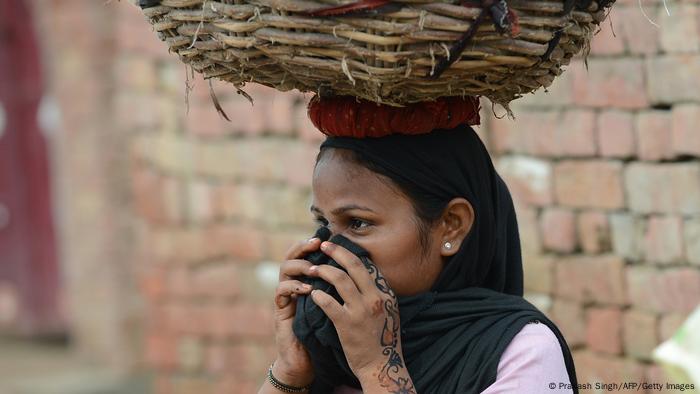India: Manual scavengers continue to remove human waste by hand despite ban
Manual scavenging is banned in India, but the caste-based practice — which mainly employs members of the Dalit community — is still prevalent in some parts of the country and has claimed many lives.

A manual scavenger in Uttar Pradesh covers her nose while carrying human waste after cleaning toilets in Nekpur village
The Indian government in July declared that no deaths were reported in the country due to manual scavenging, prompting severe criticism from activists.
Indian authorities, however, admitted that 941 sanitation workers died nationwide while cleaning sewers and septic tanks.
Activist Bezwada Wilson from the Safai Karmachari Andolan, which works to eradicate manual scavenging, said on Twitter 472 deaths had been recorded from 2016 to 2020, with 26 deaths so far this year due to the practice.
Manual scavenging is the practice of physically removing human excreta by hand from sewers or septic tanks. The work is mostly undertaken by members of the Dalit caste, which is at the bottom of India's archaic caste system.
Women are also employed in large numbers in this practice, particularly in rural areas.
Manual scavenging is banned in India, but the caste-based practice — which mainly employs members of the Dalit community — is still prevalent in some parts of the country and has claimed many lives.

A manual scavenger in Uttar Pradesh covers her nose while carrying human waste after cleaning toilets in Nekpur village
The Indian government in July declared that no deaths were reported in the country due to manual scavenging, prompting severe criticism from activists.
Indian authorities, however, admitted that 941 sanitation workers died nationwide while cleaning sewers and septic tanks.
Activist Bezwada Wilson from the Safai Karmachari Andolan, which works to eradicate manual scavenging, said on Twitter 472 deaths had been recorded from 2016 to 2020, with 26 deaths so far this year due to the practice.
Manual scavenging is the practice of physically removing human excreta by hand from sewers or septic tanks. The work is mostly undertaken by members of the Dalit caste, which is at the bottom of India's archaic caste system.
Women are also employed in large numbers in this practice, particularly in rural areas.
A 'dehumanizing practice'
The Indian government distinguishes between manual scavenging and the practice of cleaning sewers and septic tanks. But labor activists argue that the latter is a mere extension of the former.
The term "manual scavenger" broadly represents sanitation workers who are involved in cleaning, carrying and disposing of untreated human excreta.
India has banned the practice under the Prohibition of Employment as Manual Scavengers and their Rehabilitation Act, 2013.
Outlawing the practice began in 1993, but in 2013, the definition of manual scavengers was broadened to include people employed to clean septic tanks, ditches or railway tracks.
The Act recognizes this as a "dehumanizing practice," and cites a need to "correct the historical injustice and indignity suffered by the manual scavengers."
However, a lack of implementation has led to the continuation of the practice in several parts of the country. A 2019 study by the World Health Organization (WHO) said "weak legal protection and lack of enforcement" of the laws, as well as the poor financial status of sanitation workers, contributes to the practice still prevailing
Watch video03:30
Can India overcome its social divide?
The study, authored jointly by the World Bank, WHO, International Labor Organization (ILO) and WaterAid, said that sanitation workers are poorly and irregularly paid. The study found that in some cases, workers had money extored from them or were paid in leftover food or basic food items.
"No one does this kind of work by choice. We are stuck in this profession, but we want a better life for our children. We suffer and our families suffer due to the social stigma," a sanitation worker based in Uttar Pradesh told DW.
Many who refuse to work as scavengers face coercion and threats from dominant castes, according to a Human Rights Watch report published in 2014.
Last year, the Indian government announced a slew of measures under the Swachh Bharat Abhiyaan (Clean India initiative) to end the discriminatory and hazardous practice of manual scavenging by August 2021.
The goal is far from complete, as Minister of State for Social Justice and Empowerment Ramdas Athawale said 66,692 manual scavengers were identified across the country during parliamentary proceedings last month.
Life-threatening work
Manual scavengers are at risk of death from asphyxiation due to poisonous gases and are often exposed to diseases such as cholera, hepatitis, meningitis, jaundice, skin disorders and even cardiovascular diseases. They often lack access to proper safety gear and equipment.
"Most of the deaths reported are due to accidents in septic tanks and sewer areas. A lack of precautions, such as taking lamps down in sewers with a large concentration of methane gas, is responsible for accidents," said Bindeshwar Pathak, founder of the NGO Sulabh International.
Some states including Delhi have launched the use of sewage cleaning machines for this purpose. However, they are not widely used across the country. Moreover, narrow lanes prevent access for larger machines while poorly designed septic tanks make it difficult for machines to function.
Prime Minister Narendra Modi's push to provide toilets to every household across the country sought to reduce defecation in the open. Many NGOs are also working to educate and train workers for other vocations, so that they are not forced to work as manual scavengers.
"Organizations and the government have to come together in solving the problem, with zeal and sincerity," says Pathak.
SEE
No comments:
Post a Comment